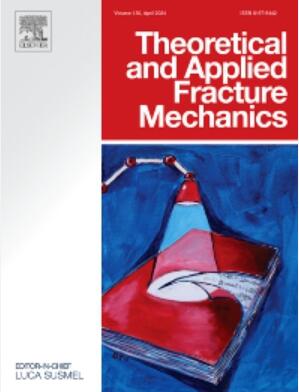Sensitivity analysis of carbon fiber reinforced asphalt pavements: Experimental study and data driven predictive model using machine learning
IF 5
2区 工程技术
Q1 ENGINEERING, MECHANICAL
引用次数: 0
Abstract
It is well known that the impact of fibers on reinforcing asphalt pavement (AP) has been extensively investigated. However, the optimal fiber length and content considering various temperatures is still an unresolved issue in this field. To reach this goal, this research aims to study the impact of carbon fiber (CF) reinforcement on the fracture energy and toughness of AP under varying environmental conditions. Several mix designs considering different CF length (10–30 mm) and content (1–3.5 %) at 5 °C and ambient temperatures were evaluated to determine the optimal values. The results demonstrated that while increasing CF length and content generally improves fracture energy and toughness, there is an optimal threshold beyond which additional CF content yields diminishing returns. Notably, the sample with a 1.5 % replacement ratio and 15 mm CF length exhibited superior performance, significantly enhancing the AP’s resistance to fracture due to effective stress distribution and crack bridging. Conversely, samples with the higher fiber content and length showed decreased fracture toughness, due to fiber clustering and reduced workability. Additionally, experimental results indicated higher values at 5 °C for fracture energy and toughness. Advanced machine learning techniques were also utilized to develop predictive models to accurately simulate the fracture behavior of CF-reinforced AP mixtures. Among all models, Gaussian process regression demonstrated superior performance and exhibited lower error in predicting experimental data. Moreover, a sensitivity analysis of this model was conducted to determine how the length and content of CF, as well as temperature, influence fracture energy and toughness, guiding the optimization of CF integration in AP design. These findings provide valuable insights for engineering durable and resilient asphalt pavements capable of withstanding diverse climatic stresses, ultimately contributing to more sustainable and cost-effective infrastructure solutions.
碳纤维加固沥青路面的敏感性分析:实验研究和使用机器学习的数据驱动预测模型
众所周知,纤维对加固沥青路面(AP)的影响已得到广泛研究。然而,考虑到各种温度条件下的最佳纤维长度和含量仍是该领域的一个未决问题。为了实现这一目标,本研究旨在研究不同环境条件下碳纤维(CF)加固对沥青路面断裂能和韧性的影响。在 5 °C 和环境温度下,对不同碳纤维长度(10-30 毫米)和含量(1-3.5%)的几种混合设计进行了评估,以确定最佳值。结果表明,虽然增加 CF 长度和含量通常能提高断裂能和韧性,但存在一个最佳阈值,超过该阈值,增加 CF 含量的收益就会递减。值得注意的是,置换率为 1.5 %、纤维长度为 15 mm 的样品表现出卓越的性能,由于有效的应力分布和裂纹桥接,AP 的抗断裂性显著提高。相反,纤维含量和纤维长度较高的样品由于纤维集聚和加工性降低而导致断裂韧性下降。此外,实验结果表明,5 ° C 时的断裂能和断裂韧性值较高。我们还利用先进的机器学习技术开发了预测模型,以准确模拟 CF 增强 AP 混合物的断裂行为。在所有模型中,高斯过程回归在预测实验数据方面表现出更优越的性能和更低的误差。此外,还对该模型进行了敏感性分析,以确定 CF 的长度和含量以及温度对断裂能和韧性的影响,从而指导优化 AP 设计中的 CF 集成。这些研究结果为设计能够承受各种气候应力的耐久性和弹性沥青路面提供了宝贵的见解,最终有助于提供更具可持续性和成本效益的基础设施解决方案。
本文章由计算机程序翻译,如有差异,请以英文原文为准。
求助全文
约1分钟内获得全文
求助全文
来源期刊

Theoretical and Applied Fracture Mechanics
工程技术-工程:机械
CiteScore
8.40
自引率
18.90%
发文量
435
审稿时长
37 days
期刊介绍:
Theoretical and Applied Fracture Mechanics'' aims & scopes have been re-designed to cover both the theoretical, applied, and numerical aspects associated with those cracking related phenomena taking place, at a micro-, meso-, and macroscopic level, in materials/components/structures of any kind.
The journal aims to cover the cracking/mechanical behaviour of materials/components/structures in those situations involving both time-independent and time-dependent system of external forces/moments (such as, for instance, quasi-static, impulsive, impact, blasting, creep, contact, and fatigue loading). Since, under the above circumstances, the mechanical behaviour of cracked materials/components/structures is also affected by the environmental conditions, the journal would consider also those theoretical/experimental research works investigating the effect of external variables such as, for instance, the effect of corrosive environments as well as of high/low-temperature.
 求助内容:
求助内容: 应助结果提醒方式:
应助结果提醒方式:


